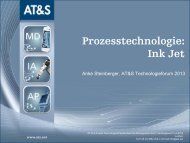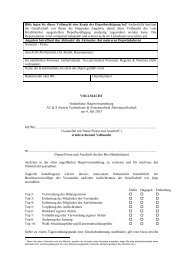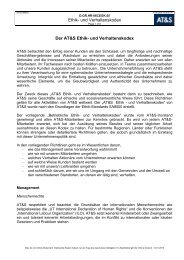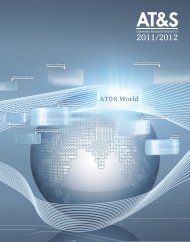AT&S World
AT&S World
AT&S World
You also want an ePaper? Increase the reach of your titles
YUMPU automatically turns print PDFs into web optimized ePapers that Google loves.
The acquisition method of accounting is used to account for the<br />
acquisition of subsidiaries. The consideration transferred for<br />
the acquisition is the fair values of the assets transferred, the<br />
equity interests issued by the Group and the liabilities incurred<br />
or assumed at the date of the transaction. The consideration<br />
transferred includes the fair value of any asset or liability resulting<br />
from a contingent consideration arrangement. Acquisition-related<br />
costs are expensed as incurred. Identifiable assets<br />
acquired and liabilities and contingent liabilities assumed in a<br />
business combination are measured initially at their fair values<br />
at the acquisition date.<br />
The excess of the consideration transferred, the amount of any<br />
non-controlling interest in the acquiree and the acquisition-date<br />
fair value of any previous equity interest in the acquiree over the<br />
fair value of the Group’s share of the identifiable net assets acquired<br />
is recorded as goodwill. For each business combination,<br />
the acquirer shall measure any non-controlling interest in the<br />
acquiree either at fair value or at the non-controlling interest’s<br />
proportionate share of the acquiree’s identifiable net assets and,<br />
accordingly, recognize the full or proportional goodwill. If the<br />
consideration transferred is less than the fair value of the net<br />
assets of the subsidiary acquired, the difference is recognised<br />
directly in the income statement.<br />
When the Group ceases to have control or significant influence<br />
over a company, any retained interest in the entity is remeasured<br />
to its fair value, with the change in carrying amount recognised<br />
in profit or loss. The fair value is the initial carrying amount for<br />
the purposes of subsequently accounting for the retained interest<br />
as an associate, joint venture or financial asset. In addition, any<br />
amounts previously recognised in other comprehensive income<br />
in respect of that entity are accounted for as if the group had<br />
directly disposed of the related assets or liabilities. This means<br />
that a profit or loss previously recognised in other comprehensive<br />
income is reclassified from equity to profit or loss.<br />
Consolidated Financial Statements as of 31 March 2011<br />
Consolidation policies<br />
All significant intercompany accounts and transactions have<br />
been eliminated so that the consolidated financial statements<br />
present the accounting information of the Group as if it were<br />
one single company.<br />
Investments in subsidiaries are consolidated in accordance with<br />
IAS 27 “Consolidated and Separate Financial Statements”, Intercompany<br />
accounts receivable and payable as well as expenses<br />
and income are eliminated. Unless immaterial, intercompany<br />
results in non-current assets and inventories are eliminated.<br />
Uniform accounting and valuation methods are applied to all<br />
consolidated subsidiaries.<br />
The Group treats transactions with non-controlling interests as<br />
transactions with equity owners of the Group. For purchases<br />
from non-controlling interests, the difference between any consideration<br />
paid and the relevant share acquired of the carrying<br />
value of net assets of the subsidiary is recorded in equity. Gains<br />
or losses on disposals to non-controlling interests are also recorded<br />
in equity.<br />
b. Segment reporting<br />
An operating segment is a component of an entity that engages<br />
in business activities and whose operating results are reviewed<br />
regularly by the entity’s chief operating decision maker. Business<br />
activities involve earning revenue and incurring expenses,<br />
and these may also relate to business transactions with other<br />
operating segments of the entity. Discrete financial information<br />
is available for the individual operating segments. The chief operating<br />
decision maker of the Group is the Management Board<br />
of the Company.<br />
According to the internal reporting by regional production sites,<br />
a distinction has to be made between the two operating segments,<br />
Europe and Asia. The Europe operating segment includes the activities<br />
of the production sites in Austria, and the Asia operating<br />
segment the activities of the production sites in China, India and<br />
South Korea. The operating segments also include the distribution<br />
activities attributable to the respective production sites.<br />
61

















